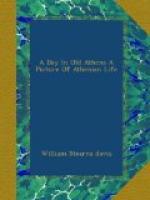Phormion passes under the eastern porch, and does not forget (despite the purification before the sacrifice) to dip the whisk broom, lying by the door, in the brazen laver of holy water and again to sprinkle himself. He passes out of the dazzling sunlight into a chamber that seems at first to be lost in a vast, impenetrable gloom. He pauses and gazes upward; above him, as little by little his eyes get their adjustment, a faint pearly light seems streaming downward. It is coming through the translucent marble slabs of the roof of the great temple.[*] Then out of the gloom gleam shapes, objects,—a face. He catches the glitter of great jewels and of massy gold, as parts of the rich garments and armor of some vast image. He distinguishes at length a statue,—the form of a woman, nearly forty feet in height. Her left wrist rests upon a mighty shield; her right hand holds a winged “Victory,” itself of nigh human size. Upon her breast is the awful egis, the especial breastplate of the high gods. Around the foot of her shield coils a serpent. Upon her head is a might helmet. And all the time that these things are becoming manifest, evermore clearly one beholds the majestic face,—sweetness without weakness, intellectuality without coldness, strength mingled justly with compassion. This is the Athena Parthenos, the handiwork of Phidias.[+]
[*]This seems to be the most reasonable way to assume that the “cella” of the Parthenon was lighted, in view of the danger, in case of open skylights, of damage to the holy image by wind and rain.
[+]Of this statue no doubt there could be said what Dion Chrysostomos said of the equally famous “Zeus” erected by Phidias at Olympia. “The man most depressed with woes, forgot his ills whilst gazing on this statue, so much light and beauty had Phidias infused within it.” Besides the descriptions in the ancient writers we get a clear idea of the general type of the Athena Parthenos from recently discovered statuettes, especially the “Varvakeion” model (401/2 inches high). This last is cold and lifeless as a work of art, but fairly accurate as to details. [Note from Brett: In 2001, this remains the best statue ever found representing Athena Parthenos and a detailed analysis of the effect of the original statue on the populous can be found at http://www.open.ac.uk/Arts/cc96/lapatin.htm. The statuette itself is currently in the Athens Museum.]
We will not heap up description. What boots it to tell that the arms and vesture of this “chryselephantine” statue are of pure gold; that the flesh portions are of gleaming ivory; that Phidias has wrought the whole so nobly together that this material, too sumptuous for common artists, becomes under his assembling the perfect substance for the manifestation of deity?
...Awestruck by the vision, though often he has seen it, Phormion stands long in reverent silence. Then at length, casting a pinch of incense upon the brazier, constantly smoking before the statue, he utters his simple prayer.




